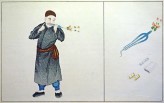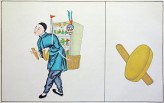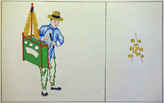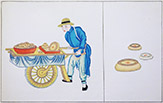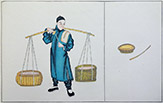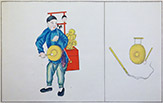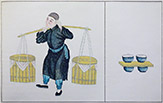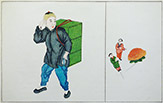This type is another difficult one to catalog. In olden times there were many of them in Peking but they are growing less as the drug shops increase. They carry a bag or box in which they keep all sorts of medicines. Their stock in trade is a plaster made from medicinal substances and mixed with sesame seed oil to form a thick, dark colored salve. This is backed with cloth, heavy paper, or silk and put over the spot where the patient’s ailment lies.
In addition to the plaster of thick salve called “Kao yao”, there is added a little special medicine depending on whether the patient is suffering from blood, bone, muscle, or other trouble. This of course is a very primitive form of medical treatment and slowly going out of fashion within the city walls of Peking. However, in the country, outside the walls, this medicine man does a thriving business. In this case he becomes less of a peddler type and more of a doctor.
Many of these “country doctors” have a mule or camel on which they pack their medicines and as doctors do not abound in the country, their services are much in demand. They travel from town to town, staying in each as long as trade is good, and return to Peking to replenish their stock of medicines when necessary. Their treatments are all by external applications.
These medicine men announce their presence by an instrument called a “hu ch’eng tzu” or “tiger stretcher”. This is a hollow iron ring like a doughnut with a slit cut all around the outer edge. Inside the ring are several small iron balls. This ring is carried over all fingers placed points together or over the thumb alone. As the medicine man walks along the ring is shaken or revolved around the thumb as the case may be and the balls rolling around the hollow ring make a very resonant sound, characteristic of the “country doctor”.
This “hu ch’eng tzu” or “tiger stretcher” has quite a history. It seems that in the olden days – the Han Dynasty to be more or less exact – there was a well known doctor by the name of Hua T’o. He is the same doctor who is supposed to have cured Kuan Lao Yeh from the effects of a poisoned arrow in the days of the Three Kingdoms in the Han Dynasty. The story of this event is known as “Kua ku liao tu” or “Scraping bone to cure poison”. Hua T’o is also known for having a large number of medical books. When imprisoned by Ts’ao Ts’ao for prescribing a cure which the latter thought dangerous he was sentenced to death. Hua T’o gave his medical books to an official who had been kind to him in prison. The official went to the doctor’s house to find the wife of Hua T’o in the act of burning the books. He succeeded in saving all those pertaining to animal diseases but only part of those concerning the curing of human ills. The Chinese claim that this is the reason for their doctors being excellent in the care of animals but not so good in the care of humans.
However this may be, the same Hua T’o is also credited with the origin of the “hu ch’eng tzu” or “tiger stretcher”. He is supposed to have been travelling from one village to another in the mountains. On the road he met a tiger which was in great pain. The animal asked him to cut a growth out of its throat but Hua T’o could think of no way to do it. He told the tiger to meet him the next day and he would try to think of a plan. That evening in a nearby village the doctor had made an iron ring like a doughnut after the type described above. This he placed in the tiger’s mouth so the teeth could not close and through the hole in the center was able to cut the growth from the throat of the tiger. After this Hua T’o carried the iron ring with him and it became a regular part of a doctor’s equipment.


